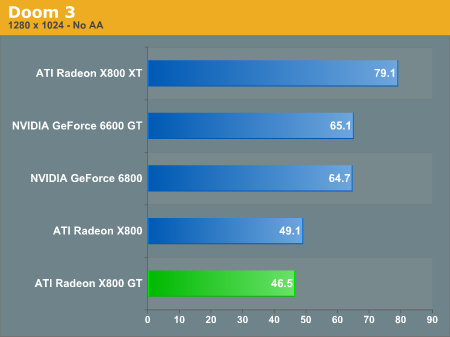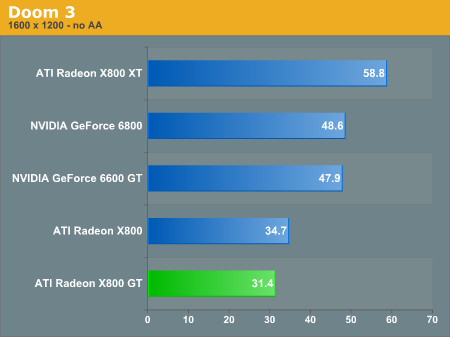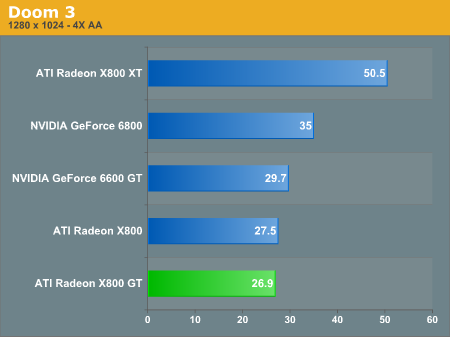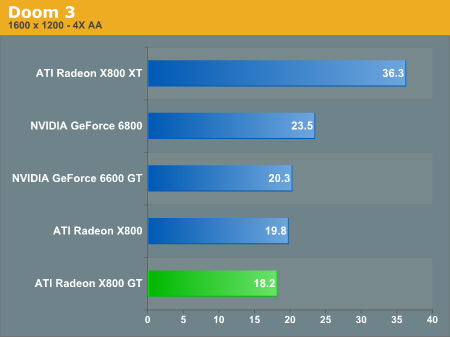ATI Radeon X800 GT: A Quality Mid-range Solution
by Josh Venning on September 28, 2005 12:05 AM EST- Posted in
- GPUs
Doom 3 Performance
Doom 3 is known to favor the architecture of NVIDIA, given their "Ultra Shadow" technology and Doom 3's impressive use of it for lighting effects. Before you simply pass by these results because you don't like the game, remember that there are several titles coming out in the near future that will use the same engine. Quake 4 and Enemy Territory: Quake Wars look to take the technology demo known as Doom 3 and turn it into a truly great gaming experience. (Yes, many people loved Doom 3, and we're not trying to start that debate again.)
You can see that once AA is enabled, the gap closes considerably, and the 6600 GT's framerate falls to levels that aren't really playable. X800 GT takes a smaller hit in performance with AA enabled by comparison – it's 40% slower at 1280x1024 where the 6600GT is 55% slower. Its much higher (nearly double the 6600GT) bandwidth helps, but it still comes out behind – and none of the cards other than the X800 XT are playable with 4xAA. Note that as with BF2, the framerate that the X800 GT gets is very playable at 1280x1024.
Doom 3 is known to favor the architecture of NVIDIA, given their "Ultra Shadow" technology and Doom 3's impressive use of it for lighting effects. Before you simply pass by these results because you don't like the game, remember that there are several titles coming out in the near future that will use the same engine. Quake 4 and Enemy Territory: Quake Wars look to take the technology demo known as Doom 3 and turn it into a truly great gaming experience. (Yes, many people loved Doom 3, and we're not trying to start that debate again.)




You can see that once AA is enabled, the gap closes considerably, and the 6600 GT's framerate falls to levels that aren't really playable. X800 GT takes a smaller hit in performance with AA enabled by comparison – it's 40% slower at 1280x1024 where the 6600GT is 55% slower. Its much higher (nearly double the 6600GT) bandwidth helps, but it still comes out behind – and none of the cards other than the X800 XT are playable with 4xAA. Note that as with BF2, the framerate that the X800 GT gets is very playable at 1280x1024.










48 Comments
View All Comments
ixelion - Wednesday, September 28, 2005 - link
I thinks its important to note if one is building a mid range gaming machine and loocking for the best bang foe the buk, then one would be better off with an AGP system with a 6800nu from a decent manucaturer.getting this card to 16 pipelines and at its default clock of 350Mhz (BFG) you get 5.6GPixel fillrate which I think supreseeds all of the cards in the article.
One should also consider that ATI is releasing some lower level cards using the higher end cores which *might* be good cards for pipelne unlocking provided they dont lock the pipes.
acx - Wednesday, September 28, 2005 - link
6800 is performing better in EQ with 1600x1200 4XAA than 1280x1024 4XAA??JarredWalton - Wednesday, September 28, 2005 - link
Hmmm... looks like a typo. It looks like 21.6 instead of 11.6 would be more appropriate, given the other charts. Not like either is really good.DerekWilson - Wednesday, September 28, 2005 - link
well ... actually ... it's not a typo ...we tested and retested ... but kept getting the same thing.
we can't explain it. sorry we glossed over it, but we are looking into. we should have mentioned it.
yacoub - Wednesday, September 28, 2005 - link
Hey, can you change the teaser line on the frontpage to read, "ATI's answer to a question nobody asked."? That would be much more humorous and accurate. As much as I love my ATi cards, I am really disappointed in them just throwing away all of their initiative this year with long product delays, paper launches, and putting out cards that don't meet the needs of the main gaming fanbase.sri2000 - Wednesday, September 28, 2005 - link
A bit OT, but from the 2nd to last page: "While 236 Watts might seem like a lot, keep in mind that with NVIDIA's 7800 series cards, we've seen power draws as high as 280 Watts..."I'm no expert, but if your looking at systems where the max draw is 280 watts, then what would be the point of having a PSU of more than 300 watts (as long as that 300wat PSU is of high quality).
Wouldn't getting 400/500/and even 600W power supplies just be a waste of money - a victim to manufacturers' bogus marketing?
Just askin'
Pythias - Wednesday, September 28, 2005 - link
Thing is cheap power supplies rated at 300 rarely hit 300w and if you look at the systems most of that draw is on the 12v rail. Also if you get a good power supply, rated higher than you need, its going to me more efficient handling smaller loads. Thats means lower energy bills.sri2000 - Wednesday, September 28, 2005 - link
One reason I brought it up is I saw reviews of the Antec Phantom PSUs at silentpcreview.com, and from what they say, it appears that the main difference between the two models (350W and 500W) is that the 350 is fanless, and the 500 has a fan which only kicks in when temperature/power draw warrants it.So I'm wondering how many of these high-watt PSUs are merely rated higher because they have more agressive cooling systems, and they're actually not of any better quality than their lower-rated siblings.
check out this link:
http://www.silentpcreview.com/article28-page4.html">http://www.silentpcreview.com/article28-page4.html
I guess the reason companies like Dell use relatively low-wattage PSUs is because they're less expensive & higher power units just aren't needed - and they're quieter too.
kleinwl - Wednesday, September 28, 2005 - link
That is incorrect. An overspec power supply will not be more efficent than a lower (but sufficent) psu. The best efficency is typically near full load. A half loaded psu will be much less efficent that a mostly loaded psu. Just look at the efficency curves and where they are rated at.bob661 - Wednesday, September 28, 2005 - link
Where can I get these efficency curves?